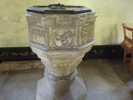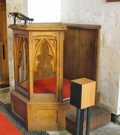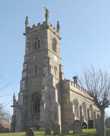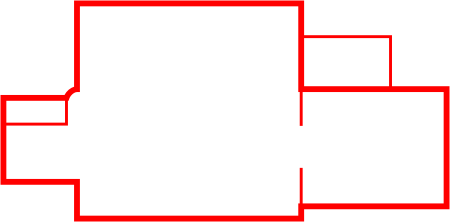For this church:    |
|
Key to Fittings |
North aisle
1Railings
Two wrought iron railings situated immediately west of the organ separate it from the seating in the north aisle. These are free-standing and not fixed to the wall.
2Kneeler
A long kneeler is between the wrought iron rails and the seating with an inscription reading:
| 1906 In memory of Fred Hempsall 1983 |
3Chairs
Twelve beechwood chairs with bookholders in the rear. Three bear a memorial plaque:
| In loving memory of Ruby Adeline Cable. Passed away 13th August 1982 |
4Statue of Our Lady
Standing on a plinth in the north wall, this statue was removed from its previous position on the altar in the former Lady chapel, now the site of the organ.
5 Font
Font
The font is of stone. It is in the octagonal perpendicular style with the eight sides having panels either of arcading or geometric patterns. There are no overtly Christian carvings. The heavy wooden cover has two iron bars over it, crossing in the middle at the handle.
This font is one of the articles surviving from the previous church. Mee suggests it is six hundred years old. Pevsner does not date it but refer to it as “Perpendicular”. It can probably be attributed to the late 14th Century. Until the 1990s it stood under the tower but was then moved to the north aisle.
Nave
8Pews
The pews, in addition to the organ, were part of a purchase from Rampton Wesleyan Methodist Chapel installed here in 1993-4. They are of oak and replaced the previous pinewood pews (It is not known if those were the original 1844 pews but their apparently dilapidated condition suggests they were.) In slightly differing styles, some of the new oak pews have five divisions for prayer books etc at the back and some four. At the ends of the pews are small inset diamond shapes within which are various foliage motifs. They probably date from 1876 when the Methodist chapel was opened.
9 Pulpit
Pulpit
The oak pulpit consists of five panels, three of which have an elongated trefoil design on the upper part, and a small wrought iron lectern affixed by a semi-circular arch with shamrock-shaped feet. There are two steps up on the south side which are at present carpeted. In a White’s directory entry of 1888 it is described as ‘new’.
Dimensions : the pulpit is 131cms in height and 98.5cms in width.
10Donations board over the doorway.
| Mr Joseph Holliday, late of Langwith in this county left the interest of forty eight pounds to be given to the poor of Bothamsall yearly for ever. The principal was deposited in the Savings Bank at Retford by Mr William Peck in 1826. |
Chancel
12Altar
Made of stone, the altar is supported by two pillars. It was given in memory of Mary Mansell, formerly of Haughton Park, by her sister.
Dimensions: The altar is 215cms long and 75cms wide. The supporting pillars are 95cms high
The inscription carved on the front of the altar reads:
| Erected to the memory of Mary Mansell, formerly of Haughton Park, by her sister |
The inscription is undated but the Mansells were associated with Haughton Park over a long period as grave markers in the churchyard attest. In addition, after various references to Mansell, his gamekeper, the 4th Duke of Newcastle records in his diary (9 Jan 1840):
‘I went to see the farm in Haughton Park which Mansell is to have. So long as I have been accustomed to Mansell as my keeper, I can hardly imagine him as one of my principal tenants’.
Haughton Park was also where the Duke’s kennels were located.
In an article on the Buslyngthorp brass published by the Thoroton society the writer explains that the brass was discovered in 1920 when the chancel floor was necessarily lifted to facilitate the erecting of a new high altar thus giving a date for the altar being installed.
13Crucifix
Situated on the altar, it is of a rather unusual design having, besides the figure of Christ, those of Mary and St John the Evangelist either side of him. These are placed in a lower position being on two narrow brass stems which arch upwards from the main stem. It is 79cms high. A handwritten statement, still in the possession of the church, states that the crucifix was the gift of the Rev Mr McLaughlin (incumbent 1889-98) in memory ‘of his dear daughter’. It was ‘accepted by us on the expressed condition that if the vicar, Churchwardens and Communicants of the parish shall ever at any time desire to remove the said crucifix, we the churchwardens will restore it to the donor, The Rev. Alfred McLaughlin or his family’ It is signed and dated 30th April 1898
The crucifix is inscribed on the base:
| AETATE QUINDECIM ANNORUM HANC CRUCEM DONUM DEDERUNT SUAE PARENTES RIP |
and round the base:
| AD DEI MAJOREM GLORIAM ATQUE IN PIAM MEMORIAM CECIL URWICK MCLAUGHLIN, QUAE OBDORMIVIT DOMINICA PALMARUM 1896 |
Although of no monetary value it is the only tangible relic of a previous incumbent in the church.








